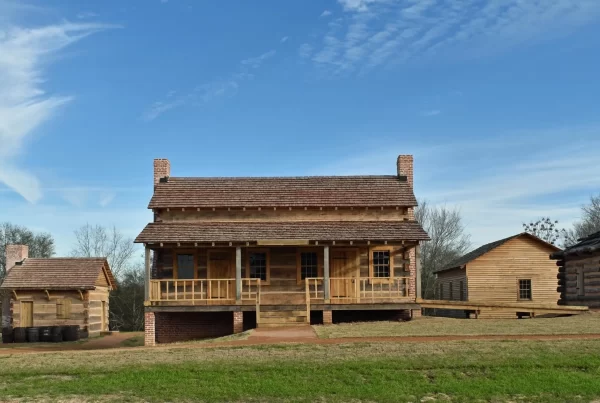When Mexico won independence from Spain in 1821, it inherited not only vast territory but also the challenge of building a functioning government over regions with stark geographic, cultural, and economic differences. The Constitution of 1824 attempted to meet that challenge by establishing Mexico as a federal republic—one that granted meaningful autonomy to its constituent states.
Under this system, states had their own legislatures and militias and enjoyed considerable control over internal affairs. For many settlers in Texas, particularly those of Anglo-American origin, the 1824 Constitution represented a workable framework that honored local control and offered legal protections.
But federalism in Mexico proved fragile. By the early 1830s, political instability, economic crises, and repeated power struggles in the capital began to weaken the system. Conservatives in Mexico City viewed the federal structure as inefficient and divisive, while military leaders sought centralized power as a means of restoring order.
These power struggles played out not only in Mexico City but also regionally and locally. In 1833-1835, the state government of Coahuila y Tejas split as feuding state leaders declared two rival capitals: a centralist-leaning capital at Saltillo, and a federalist-leaning capital at Monclova (allied with Tejanos in San Antonio). A letter from Oliver Jones, a Texan diputado in the state legislature (Congreso del Estado de Coahuila y Tejas), illustrates the tumult in the region a year before the outbreak of the Texas Revolution:
Monclova, September 2, 1834
“The political affairs of this section of the country are in a state of perfect anarchy and confusion. The state government has fallen into pieces, without leaving a foundation on which another can be constitutionally erected; on the 30th of last month, an officer of the permanent army was proclaimed governor of the state by fifteen officers of the army, two members of the ayuntamiento of this place, and three of the deputies of the congress; and the former governor turned out of office. There is not, nor will there be, any congress or permanent deputation in this place during the present year, at one time since my arrival in this city there were seven members present, two of whom were of the Saltillo party, and refused to serve; and immediately left for that place. Bascas left this morning for Texas. I shall, if permitted, remain here a few weeks longer. The government established in Saltillo still exists and [is] gaining ground. The towns of Rio Grande, Moralas, San John de Mat and Santa Rose, have declared in favour of Saltillo. There are about 500 militia and permanent troops in this place, but up to the present time they have remained inactive. The government of Saltillo appears to be on an equal footing with that of this place, and has an equal number of supporters in this part of the state… The state of Vera Cruz has, I am informed, declared in favor of a Central Government; and I have no doubt of Santa Anna’s intention to establish that form of government….”1
The final blow for federalism came in 1835, when the government formally repealed the constitution and replaced it with the Siete Leyes—a new set of laws that centralized authority in the national government and eliminated state sovereignty. The driving force behind this political transformation was Antonio López de Santa Anna, a charismatic general and political opportunist who initially rose to prominence as a defender of the federal constitution.
In the early 1830s, Santa Anna was seen by many as a liberal reformer. He was even supported by the Texian colonists in the Turtle Bayou Resolutions (1832). But after securing power, Santa Anna aligned with centralist conservatives and dismantled the very system he had once sworn to uphold. Under his leadership, state legislatures were dissolved, local autonomy was revoked, and political opposition was harshly suppressed. The shift was so abrupt and severe that it shocked even moderate federalists across the country.
Santa Anna concentrated power in the executive branch, surrounded himself with loyalists, and governed by decree. Although he claimed centralism was necessary to preserve national unity, his methods alienated entire regions and undermined the legitimacy of the Mexican state. In areas like Texas, where distance from the capital already complicated governance, Santa Anna’s policies were seen not just as overreach, but as tyranny. His name quickly became synonymous with the death of the 1824 Constitution and the betrayal of the federal compact.
Unrest or uprisings erupted in several regions of Mexico, including Zacatecas, Jalisco, and Coahuila y Tejas. Local leaders viewed the dismantling of federalism as unconstitutional and illegitimate. In Texas, where the population included a large number of immigrants from the United States, the reaction was particularly severe. Anglo-Texans and many Tejanos alike had settled under the legal promise of state-level governance. With that promise broken, resistance quickly turned into open revolt.
Tensions in Texas had already been building before the repeal of the 1824 Constitution. Mexican officials were wary of the growing Anglo-American presence and had begun to restrict immigration and land grants. The Law of April 6, 1830 halted U.S. immigration into Texas and aimed to tighten national control. These efforts only worsened relations and strengthened the resolve of settlers who believed they had been invited under one set of rules, only to have the ground shift beneath them.
Few individuals better embodied the early hopes and later disillusionment of the federal period than Stephen F. Austin, often called the “Father of Texas.” Austin had worked diligently throughout the 1820s to bring settlers to Texas under the Mexican colonization laws, and he initially supported cooperation with the Mexican government. Fluent in Spanish and well-versed in Mexican legal structures, Austin urged Anglo settlers to adopt Mexican citizenship and abide by the federal constitution.
For a time, Austin served as a mediator between the settlers and Mexican authorities, warning against rash rebellion and emphasizing the need for patience and diplomacy. That delicate balance collapsed after Austin’s arrest in 1834. While attempting to advocate for separate statehood for Texas within the Mexican system, Austin was imprisoned in Mexico City for over a year without trial.
Though eventually released, Austin’s imprisonment profoundly changed his political outlook. Long considered a moderate voice, Austin now began to speak more openly of defending Texan rights through armed means. His experience reflected the broader arc of Texan sentiment: from federal loyalty to revolutionary defiance.
As unrest spread, a series of confrontations escalated the situation. In the town of Gonzales, Texan militia members refused to return a cannon lent to them for defense, leading to a skirmish widely seen as the first battle of the Texas Revolution.
By late 1835, the rhetoric of restoration—calls to reinstate federalism—gave way to declarations of independence. When delegates met at Washington-on-the-Brazos in March 1836, they issued a formal declaration that framed their cause not as rebellion, but as the defense of rights guaranteed under a discarded constitution.
Elsewhere in Mexico, resistance to centralism continued, but most regions were eventually brought to heel. Texas, with its distance, its armed population, and the military overreach of the Mexican regime, proved harder to pacify. The new centralist government underestimated the level of discontent on the northern frontier—and overestimated its own capacity to impose order. After the Battle of San Jacinto in April 1836, the separation of Texas from Mexico became a political and military reality.
Texan independence had its roots not only in cultural differences or settler ambitions, but also in a broader constitutional crisis that reshaped the Mexican republic. Mexico’s retreat from federalism helped fuel the very separatism it had hoped to suppress. In trying to impose unity from the center, the government instead fractured the republic—and lost the vast territory of Texas in the process.
- The Texas Republican (Brazoria, TX), vol. 1, no. 13, ed. 1 (October 25, 1834), https://texashistory.unt.edu/ark:/67531/metapth80247/m1/2/ ↩︎
📚 Curated Texas History Books
Dive deeper into this topic by purchasing any of these handpicked titles:
- The Mexican Frontier, 1821-1846: The American Southwest Under Mexico
- Forging Mexico, 1821-1835
- Santa Anna of Mexico (Biography)
As an Amazon Associate, Texapedia earns a commission from qualifying purchases. Earnings are used to support the ongoing work of maintaining and growing this encyclopedia.



